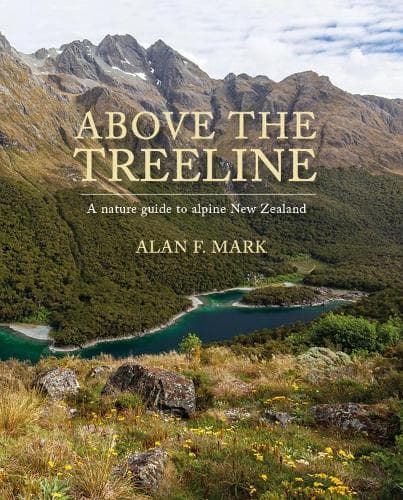Review: Above the Treeline: a nature guide to alpine New Zealand (2021 edition)
Reviewed by Alison Ballance
“Wow, what a beautiful behemoth of a book!” was my reaction when Above the treeline – a nature guide to alpine New Zealand landed on my doorstep with a thump.
I am already the proud owner of the first edition of the book, which started out life in 2012 as a slightly weighty field guide. However, a quick side-by-side comparison confirmed my suspicion that, at twice the dimensions of the ancestral volume, the thoroughly revised supersized version of the book has well and truly moved out of the backpack and onto the coffee table.
Even the author, emeritus professor Sir Alan Mark, joked to Kathryn Ryan on RNZ that he referred to it as a “weighty tome.” Nonetheless, it still serves primarily as an identification guide, although the additional page space gives the book’s more than 1300 fine photos room to breathe.
The book’s focus is the area above the treeline, that often-sharp horizontal zone on a mountain above which cold temperatures and bitter winters stop the trees growing. New Zealand’s high mountain lands cover about 9 percent of the North and South islands and include a wide range of habitats, from alpine gardens redolent with spring flowers, to grasslands, watery places such as fens and flushes, and dry areas such as scree slopes and fellfields.
The expanding girth of the book reflects a large increase in the number of alpine species that we now recognise inhabit the mountains of New Zealand – nearly 800 plant species, compared to just over 600 that Sir Alan featured in his first book on the subject, New Zealand’s alpine plants. Then there are the growing ranks of alpine lizards and a deeper understanding of the many invertebrates specialised to or just tolerating these varied high altitude islands.
A long time University of Otago botany professor, Sir Alan is the only person who could have produced this book but while he has tackled the conifers, flowering plants and grasses, he has had to enlist a range of other experts to introduce the fauna and some of the smaller flora such as the mosses and liverworts, lichens and fungi.
The book begins with a concise overview of the evolution of New Zealand’s mountain environment, beginning about five million years ago when the Alpine Fault began the uplift and mountain building that eventually led to a permanent alpine and subalpine zone developing less than a million years ago.
Our young mountains and youthful high montane species have also been shaped by numerous ice ages during the past 2.5 million years. The result is a uniquely New Zealand alpine zone, with many more cushion plants, tussocks and grasses and specialist plants adapted to the mobile substrate of scree slopes than other temperate alpine areas.
You could use the book solely as a reference guide but I have enjoyed just browsing, alighting with delight on photos of gorgeous flowers, complex leaf structure and jewel-like berries. Some, like the Mount Cook buttercup and Celmisia daisies, are familiar friends while others such as our sole native dandelion have me scratching my head — “are you sure that isn’t an introduced weed?” —although pleasingly there are very few of those. What about primitive ferns such as adder’s tongue or Ophioglossum? I had no idea there were so many different kinds of alpine lichens, ranging in texture from pink-flecked cabbage leaf to black tangled hair and red bobbles.
The birds include the dainty rock wren, our only true avian alpine specialist, through to kiwi and ducks and even wading birds that visit the mountains when the weather is benign but don’t stick around when winter blizzards scour the snow-covered landscape. And those lizards, especially rough-skinned geckos with jewel-like markings and outrageous mouth colours — gorgeous.
Above the treeline is a delight that also informs. Get a copy for your home library now as it will soon be a sought-after collector’s item.
Reviewed by Alison Ballance
